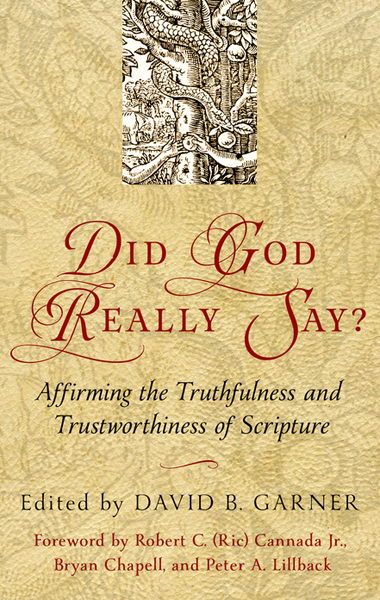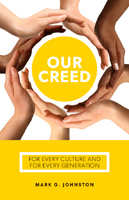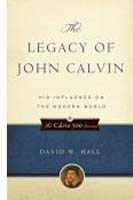
The Bible represents God’s relationship to his human creation in terms of a two covenant structure (nicely summed up in the Westminster Confession of Faith 7.3,5, and 6). God created Adam and Eve within a covenant structure called the covenant of works in which God commanded our first parents to refrain from eating from the tree of knowledge of good and evil (Genesis 2:15-17). Implicit within the warning was a promise of confirmed blessed righteousness should Adam and Eve have obeyed God. Unfortunately as Genesis 3 reveals, Adam and Eve fell for the blandishments of Satan speaking through the serpent.
With the fall of our first parents, God immediately instituted the covenant of grace in the midst of the pronouncement of curses upon the serpent, Eve, and Adam (Genesis 3:14-19). God’s replacing Adam and Eve’s fig leaves with animal skin garments was symbolic of the necessity of blood-shedding for the forgiveness of sin (Genesis 3:21; Hebrews 9:22) and pointed forward to the consummate blood-shedding of Jesus Christ the Lamb of God.
God was not surprised by these turns of events. God the Father, Son, and Holy Spirit had entered into an agreement to redeem a people and the Son voluntarily undertook to become incarnate for the salvation of his own people. The Father sent the Son, and the Son came as the God-man Mediator, and the Spirit empowered the Son to perform his work, and became the gift given to the Son who then poured him out on the church (Acts 2:17). This pre-temporal agreement is sometimes called the pactum salutis, or the covenant of redemption or covenant of peace. Some theologians include this covenant within the covenant of grace but it seems best to distinguish it from its temporal enactment in history. Whenever Jesus’ pre-existence is affirmed we have an implicit reference to the covenant of redemption. For instance, in his high priestly prayer Jesus prays to the Father that he would be glorified with the glory he had before he became incarnate (John 17:5).
The covenant of grace is descriptive of God’s intent to save a people for himself beginning with the fall in Eden and culminating in the new heavens and new earth (Revelation 22:21). As the Westminster Confession of Faith 7.5 & 6 points out, this covenant is administered differently in the old covenant era and the new covenant era. Actually, as we observe the one covenant of grace advancing through redemptive history we find it gaining in clarity and specificity.
After the first adumbration of the gospel in Genesis 3:15 God enters into covenant with Noah after he brings Noah and his family and Noah’s zoo through the universal deluge that destroyed all other life. In Genesis 8 & 9, God promises never again to destroy life by a flood. This covenant is often understood to be a common grace covenant made with all creatures. That appears to be correct. But it should be pointed out that this common grace covenant is given to further the progress of the covenant of grace. In other words, it does not exist for its own sake. Common grace subserves special grace.
Beginning with the introduction of Abraham and Sarah in Genesis 12, the covenant of grace makes great strides forward as God unfolds his plan of redemption. Repeatedly God tells Abraham that through him all the nations of the earth would be blessed (Genesis 12, 15, 17, & 22). In Genesis 15:12-21 God puts Abraham asleep and appears as a flaming torch and smoking pot in a vision in which the pot and torch pass between pieces of severed animals in a covenant ratification ceremony. The upshot of this vision was that God was promising that he himself would satisfy the demands of the covenant. Once more we get a glimpse of the coming sacrificial work of Christ.
Many years later when the descendents of Abraham had increased and relocated to Egypt and come under the hegemony of Pharaoh God heard the cries of his enslaved people and sent Moses to free them from bondage (Exodus 3). After a series of miraculous displays of God’s mighty power in ten plagues the children of Israel finally left Egypt and were led through the Red Sea on dry ground and camped at the base of Mount Sinai where God gave them his Ten Commandments explaining how he expected his redeemed people to behave in his presence (Exodus 20). Sadly the history of the people of Israel is a history of one season of disobedience followed by another. This is illustrated most clearly in Exodus 32 and the creation of the golden calf. While Moses was up on the mount receiving the ten words the people were down in the valley breaking all ten of God’s commandments.
God furthered his covenant of grace with his promise to King David that he would build for him an everlasting dynasty (2nd Samuel 7). David had wanted to build God a permanent dwelling place in Jerusalem but God told him that privilege would fall to David’s son Solomon. But God did promise David that he would always have a descendent to sit upon the throne of Israel. This promise was not fulfilled in Solomon but would be fulfilled in the ministry of David’s greater Son Jesus Christ.
The ever disobedient people of Israel would find themselves in trouble throughout their history and finally, previously torn into two kingdoms, each would be crushed and taken into captivity. The northern kingdom would disappear from the pages of history but the southern kingdom would not be completely wiped off the map. Judah would be conquered by Babylon because of her idolatry. God constantly had to deal with his people’s failure to internalize the law he had given at Sinai. God sent many prophets to his kings and the people over the years to call them to repentance and to return their God, the Holy One of Israel. Isaiah told of a Suffering Servant who would die for the sins of his people and who heal them of their sin (Isaiah 52:13-53:12). Jeremiah spoke of God giving his people law-engraved hearts so that they would do God’s will. He spoke in terms of a new covenant (Jeremiah 31:31-34). Ezekiel, the exilic prophet spoke of God replacing his peoples’ hearts of stone and replacing them with hearts of flesh (Ezekiel 36:22-38) and giving them the Spirit who would direct them in paths of obedience.
This new covenant would find its clear expression in the life and ministry of Jesus Christ. Jesus was the long-anticipated Messiah, he was the Suffering Servant and he was himself the covenant between God and his people (Isaiah 49:8). Jesus picks up on the new covenant language in his institution of the Lord’s Supper. Sharing the cup of wine with his disciples on the night before he would be put to death on a cross he said that “this cup is the new covenant in my blood” (1st Corinthians 11:25). The new covenant, which is the culmination of all the stages of the covenant of grace, is both already enacted and yet awaits its consummation in the return of Christ in glory at the end of the ages. Christ’s atoning death and resurrection are God’s answer to sin. There is no other and there is no better solution to our plight. The covenant of grace which began in Eden finds its completion in the garden city of the New Jerusalem. There the Lamb of God who was foreshadowed in the animal garments given to our first parents sits upon the throne and receives adoration. There in that place we will worship the Triune God in beautiful splendor without pain or tears. Till then we gather every Lord’s Day to celebrate the culmination of the covenant of grace in Jesus Christ.
Jeffrey C. Waddington (Ph.D., Westminster Theological Seminary) is stated supply at Knox Orthodox Presbyterian Church. He also serves as a panelist at Christ the Center and East of Eden and is the secretary of the board of theReformed Forum. Additionally he serves as an articles editor for the Confessional Presbyterian Journal.

The Alliance of Confessing Evangelicals is member supported and operates only by your faithful support. Thank you.















 © Alliance of Confessing Evangelicals
© Alliance of Confessing Evangelicals


